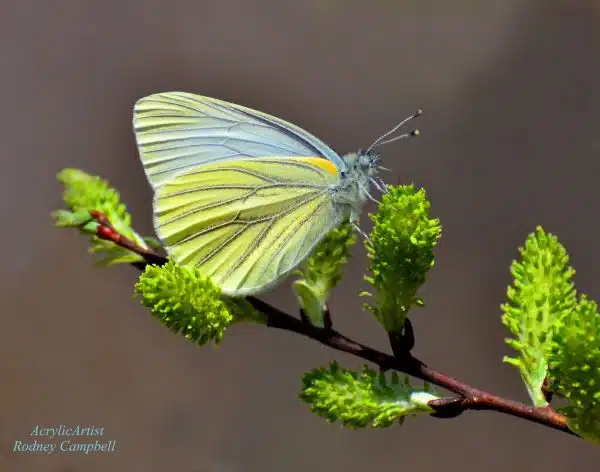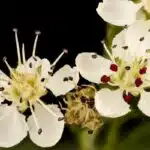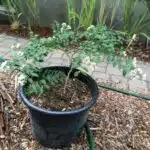Spicebush, also known as Lindera benzoin, is a hardy shrub native to the eastern United States. This plant is a favorite among garden enthusiasts due to its ornamental value and culinary applications. Spicebush is commonly used in seasoning dishes with its aromatic leaves, twigs, and berries. It is also known for its medicinal properties that have been used for centuries by Native Americans.
Growing and caring for spicebush requires some knowledge of the plant’s growing conditions and maintenance requirements. This article aims to provide an overview of how to grow and care for spicebush effectively. It covers essential aspects such as soil requirements, watering needs, pruning techniques, pest control measures, and propagation methods. By following these guidelines, gardeners can ensure that their spicebush thrives in their gardens while providing homeowners with a beautiful source of culinary and medicinal herbs.
Understanding The Basics Of Spicebush
Spicebush, also known as Lindera benzoin, is a deciduous shrub native to parts of North America. It can reach heights up to 20 feet and has an average lifespan of 20-30 years. Spicebush is a popular choice for landscaping due to its attractive foliage and fragrant flowers.
Apart from being aesthetically pleasing, spicebush also offers several benefits. Its leaves and twigs have been used in traditional medicine for their anti-inflammatory properties. Additionally, the berries of the spicebush are edible and can be used in cooking as a substitute for allspice. The plant also serves as a host plant for various pollinators such as butterflies and moths.
When it comes to landscaping, spicebush is versatile and can thrive in different types of soil as long as they are well-draining. The plant prefers partial shade but can tolerate full sun or full shade conditions. Proper care and maintenance such as regular pruning and fertilization can enhance the growth and longevity of the spicebush plant.
Planting Spicebush
When it comes to planting spicebush, the location and climate are crucial factors that can determine the success of growth. Spicebush favors moist soil and partial shade, which means it thrives in areas with high humidity levels such as woodlands, stream banks, or wetlands. The best locations for planting spicebush are those that offer consistent moisture and partial shade.
The ideal climate for planting spicebush is one that has mild winters and hot summers. Spicebush is native to eastern North America, where the temperatures range from 20°F to 100°F. These conditions make spicebush a hardy plant that can tolerate extreme heat or cold. However, it is essential to protect young plants from frost damage during the first year of growth.
To propagate spicebush successfully, you need to follow specific tips that ensure optimal germination results. Firstly, you should collect fresh seeds from ripe berries during fall or winter when they are fully matured. Secondly, soak the seeds in water for a few hours before sowing them in well-draining soil that is rich in organic matter. Lastly, keep the soil consistently moist by watering regularly but avoid overwatering as this can lead to root rot.
With these tips in mind, you can plant and grow your own spicebush with ease. The next section will discuss the soil requirements needed for healthy growth and development of this extraordinary shrubbery.
Soil Requirements For Spicebush
After successfully planting spicebush, it is crucial to ensure that the soil conditions are optimal for healthy growth. One theory suggests that spicebush thrives in acidic soil with a pH level between 4.5 and 6.0. However, it is important to note that while acidity is preferred, the soil should not be too acidic as it can lead to nutrient deficiencies and stunted growth. It is recommended to conduct a soil test to determine the pH level and make necessary adjustments.
In addition to pH levels, finding ideal soil conditions for spicebush also involves ensuring proper drainage and moisture retention. Spicebush prefers well-draining soil that retains moisture without becoming waterlogged. The addition of organic matter such as compost or leaf litter can help improve soil structure and increase water retention capacity.
To further support healthy growth, using the best fertilizers for spicebush can provide necessary nutrients such as nitrogen, phosphorus, and potassium. Organic fertilizers such as bone meal or fish emulsion are preferred over synthetic options as they promote long-term soil health and reduce the risk of chemical buildup in the soil. Incorporating these practices will ensure optimal growing conditions for your spicebush plant.
As essential as proper planting techniques are for spicebush success, maintaining healthy growth through proper watering practices is equally vital. In the subsequent section, we will explore watering needs for spicebush and how to ensure your plant receives adequate moisture without causing harm or damage.
Watering Needs For Spicebush
Watering is an essential aspect of spicebush care. It is vital to keep the soil consistently moist but not waterlogged. The frequency of watering depends on several factors such as the weather, soil type, and size of the plant.
During the growing season, it is recommended to water your spicebush once a week. However, if there has been a prolonged period without rain or high temperatures, you may need to increase watering frequency. Conversely, during periods of heavy rainfall or cooler temperatures, you can reduce watering frequency.
Overwatering can be disastrous for spicebush. Signs of overwatering include yellowing leaves and a foul odor emanating from the soil due to root rot. If you notice these signs, you should decrease watering frequency immediately and improve drainage by adding sand or perlite to your planting mix.
Moving on to fertilizing spicebush, it is equally crucial for proper growth and development.
Fertilizing Spicebush
As gardeners, we all strive for healthy and vibrant plants. Fertilizing is a crucial aspect of plant care that can make all the difference in achieving this goal. When it comes to spicebush, there are two types of fertilizers to consider: organic and synthetic.
Organic fertilizers are derived from natural sources such as compost, bone meal, or blood meal. These fertilizers release nutrients slowly over time, providing a steady supply of nourishment to the plant. This slow-release feature makes organic fertilizers an excellent choice for spicebush since these shrubs thrive on consistent feeding rather than large doses of nutrients at once.
On the other hand, synthetic fertilizers are chemical-based products that provide a quick burst of nutrients. While they may seem like an easy solution to a nutrient deficiency, their fast-acting properties can harm the soil’s microbial life and lead to imbalanced growth in plants. Therefore, it is essential to use synthetic fertilizers sparingly and follow the manufacturer’s instructions carefully.
Fertilizing your spicebush is vital for its health and overall appearance. Organic fertilizers are preferred since they provide a consistent supply of nutrients without harming the soil’s microbial life. Synthetic fertilizers should only be used when necessary and with caution. In the next section, we will discuss pruning techniques for spicebushes that will help maintain their shape and promote healthy growth.”
Pruning Techniques For Spicebush
After fertilizing your spicebush, it is important to know how to properly prune it. Pruning plays a crucial role in the overall health and appearance of the plant. The benefits of pruning include promoting new growth, maintaining a desired shape, removing dead or diseased branches, and improving air circulation.
To begin pruning your spicebush, it is important to have the right tools. Hand pruners are the best option for smaller branches while loppers can handle larger ones. It is important to keep your pruning tools sharp to prevent damaging the plant. When making cuts, be sure to cut at a slight angle just above a healthy bud or branch.
When pruning your spicebush, it is recommended to do so in early spring before new growth appears or in late fall after leaves have fallen off. Remove any dead or diseased branches first before moving on to shaping the plant. It is important not to remove more than one-third of the plant at once as this can cause stress and weaken the plant. With proper pruning techniques and tools, you can maintain a healthy and beautiful spicebush for years to come.
Moving forward with caring for your spicebush, propagation methods are an essential aspect of its growth cycle. By using these methods correctly, gardeners can establish new plants from parent plants with desirable characteristics such as color and disease resistance.
Propagation Methods For Spicebush
According to the USDA Plant Database, spicebush (Lindera benzoin) is native to the eastern United States and can grow up to 20 feet tall. It is a popular plant for landscaping due to its fragrant yellow flowers in early spring and red berries in fall. Propagation of spicebush can be achieved through air layering or stem cuttings.
Air layering is a method of propagation where a branch on the parent plant is wounded, then wrapped with moist sphagnum moss and plastic wrap to create a root ball. Once roots have formed, the new plant can be separated from the parent plant and transplanted elsewhere. Stem cuttings are another option for propagating spicebush. Select a healthy stem from the parent plant, remove leaves from the bottom half of the cutting, dip it in rooting hormone, and place it in a pot filled with moist soil. Keep the soil consistently moist until roots have formed and new growth appears.
To propagate spicebush successfully, consider these tips:
- Choose healthy stems or branches from parent plants
- Use rooting hormone when propagating by stem cuttings
- Maintain consistent moisture levels when propagating by air layering
- Transplant newly propagated plants into well-draining soil with plenty of organic matter
Next, it’s important to understand common pests and diseases that may affect your spicebush plants.
Common Pests And Diseases Of Spicebush
Spicebush is a hardy plant that is resistant to most pests and diseases. However, like any plant, it can still fall prey to a few common pests and diseases. One of the most common pests that affect spicebush is spider mites. These tiny insects are known for their ability to spread rapidly and can cause significant damage to the leaves of the spicebush.
Preventative measures include keeping the area around the spicebush clean and free from weeds or debris that may attract spider mites. It’s also important to water your plants regularly, as dry conditions can make them more susceptible to infestation. If you notice signs of spider mites on your spicebush, treatment options include spraying the leaves with an insecticidal soap or using predatory insects such as ladybugs or lacewings.
Another pest that can affect spicebush is scale insects. These small bugs feed on plant sap and can cause yellowing leaves, stunted growth, and even death if left untreated. Preventative measures include pruning back any affected branches and keeping an eye out for early signs of infestation. Treatment options include using horticultural oil sprays or introducing predator insects such as parasitic wasps.
In summary, while spicebush is generally a hardy plant, it’s important to be aware of common pests and diseases that could potentially harm it. By taking preventative measures such as keeping the area clean and free from debris, watering regularly, and monitoring for early signs of infestation, you can help ensure your spicebush remains healthy and vibrant. If an infestation does occur, treatment options such as insecticidal soaps or predatory insects can help control the problem before it gets out of hand. In the next section, we will discuss natural pest control methods for spicebush that are safe for both humans and wildlife alike.
Natural Pest Control Methods For Spicebush
Spicebush is a hardy plant that is known to repel several pests naturally. However, there are still some pests that may affect the growth and health of your spicebush. Luckily, there are natural pest control methods that you can use to keep your spicebush healthy and thriving.
One natural pest control method is companion planting. By planting certain plants next to your spicebush, you can deter pests from harming it. For example, planting marigolds or chrysanthemums near your spicebush can repel aphids and other insect pests. Planting garlic or onion nearby can also help deter pests like spider mites and whiteflies.
Another natural pest control method is using homemade remedies. You can make a homemade spray by mixing water, dish soap, and neem oil together in a spray bottle. This solution can be sprayed onto the leaves of your spicebush to repel pests like spider mites and aphids. Additionally, placing sticky traps around your spicebush can help catch flying insects like whiteflies.
Overall, utilizing companion planting and homemade remedies are great ways to naturally control pests on your spicebush without the use of harmful chemicals. With these methods in mind, you’ll be able to keep your spicebush healthy and thriving for years to come.
The use of chemical pest control methods for spicebush should be approached with caution as they may harm other beneficial organisms such as bees and butterflies in the garden ecosystem. Therefore, it’s important to exhaust all available natural pest control methods before resorting to chemical measures.
Chemical Pest Control Methods For Spicebush
Natural pest control methods are always the first line of defense in maintaining a healthy spicebush plant. However, there may be situations where chemical pest control becomes necessary. Integrated pest management (IPM) is a holistic approach to managing pests that combines the use of natural and chemical methods in a way that is environmentally responsible and economically sound.
When it comes to chemical pest control for spicebush, it is important to choose products that are specifically formulated for the pests you are trying to eliminate. Always follow instructions carefully and avoid overuse, as this can lead to negative impacts on beneficial insects and other organisms in your garden. Additionally, consider using companion planting techniques to help deter pests naturally. Some plants, such as marigolds and garlic, have been shown to repel certain pests when planted nearby.
Overall, the best approach to pest control for your spicebush plants is prevention. By providing proper care and maintenance, promoting healthy soil conditions, and incorporating natural pest control methods into your routine, you can minimize the need for chemical treatments. However, if you do encounter a significant pest problem that cannot be managed naturally or with IPM strategies alone, consult with a professional horticulturist or pesticide applicator for guidance on selecting effective products and applying them safely.
Moving forward from pest control methods, let’s now discuss harvesting spicebush.
Harvesting Spicebush
Harvesting spicebush is a crucial step in the process of growing and caring for this plant. The right time to harvest depends on the region you are in, but it generally falls between late summer and early fall when the berries have turned red. To ensure that you get the best quality berries, it’s important to pick them when they are ripe and before any frost damage occurs.
Once harvested, it’s important to know how to dry and store spicebush properly. To dry the berries, spread them out in a single layer on a clean surface and let them air-dry for several days until they’re no longer moist. Alternatively, you can use a dehydrator or oven set at a low temperature to speed up the drying process. After drying, store the berries in an airtight container in a cool, dark place where they can last up to two years.
Aside from its medicinal properties, spicebush also has culinary uses. The dried berries add a citrusy flavor to dishes like stews, soups, and marinades. You can also use fresh or dried leaves to make tea or season meats like chicken or pork. In addition, there are many recipes that call for spicebush berries such as pies, jams, and even cocktails. With its versatility in cooking and long shelf life when dried properly, having your own supply of spicebush can be both practical and rewarding.
As we’ve learned how to properly harvest and store spicebush berries, we now turn our attention toward its culinary uses. From enhancing flavors of savory dishes to adding zest into desserts and beverages- there are endless possibilities with this versatile herb!
Culinary Uses Of Spicebush
After harvesting the spicebush, it’s time to explore its culinary uses. The spicebush has a unique flavor profile that is both spicy and sweet, making it an excellent addition to many recipes. One way to use the spicebush is by incorporating its leaves or berries into teas or cocktails. Its dried berries can also be ground and used as a seasoning for meat dishes.
Apart from adding flavor to meals, the spicebush also has health benefits. Studies have shown that it contains compounds such as camphor and safrole that have antimicrobial properties. These compounds may help fight off infections caused by bacteria and fungi in the body. Additionally, spicebush is rich in antioxidants that protect cells against oxidative stress.
Here are some Spicebush recipes you can try at home:
- Spicebush tea: Steep 2-3 fresh leaves of the spicebush plant in hot water for 5 minutes.
- Spiced meat rub: Combine dried and ground spicebush berries with salt, black pepper, paprika, and garlic powder.
- Spicebush cocktail: Muddle fresh spicebush leaves with sugar and lime juice. Add ice cubes and gin or vodka then shake well.
- Pickled Spicebush Berries: Combine equal parts white vinegar and water in a saucepan then add salt, sugar, mustard seeds, peppercorns, bay leaf, sliced onions, and sliced garlic cloves. Bring to a boil then pour over cleaned spicebush berries placed inside sterilized jars.
- Spicebush butter: Mix softened butter with finely chopped fresh or dried spicebush leaves.
Incorporating spicebush into your meals not only adds flavor but also provides health benefits. In the next section, we will explore more about the medicinal properties of this versatile plant.
Medicinal Properties Of Spicebush
As the old adage goes, “an ounce of prevention is worth a pound of cure.” Spicebush (Lindera benzoin) has been revered for its medicinal properties, and for good reason. This versatile plant has a rich history in folklore and traditional medicine, as it has been used to treat a wide range of ailments.
Spicebush folklore dates back centuries, with indigenous tribes using the plant for various purposes. The Cherokee people used spicebush to treat colds and coughs, while the Iroquois used it to alleviate pain during childbirth. In modern times, studies have shown that spicebush contains compounds that have anti-inflammatory and antispasmodic effects on the body.
The traditional medicinal uses of spicebush are numerous. It has been used to treat digestive issues such as bloating and gas, as well as respiratory issues like asthma and bronchitis. Additionally, spicebush has been known to promote healthy blood flow and reduce fever. With its many therapeutic qualities, spicebush is a valuable addition to any medicinal herb garden or natural medicine cabinet.
Transitioning into other uses of spicebush: While the medicinal properties of spicebush are impressive, there are many other ways in which this plant can be utilized. From culinary uses such as seasoning meats and flavoring tea to attracting wildlife with its fragrant blooms and berries, there are endless possibilities when it comes to incorporating spicebush into your life.
Other Uses Of Spicebush
Having covered the medicinal properties of spicebush in the previous section, it is important to note that this valuable plant has other uses as well. One such use is the consumption of its berries, which are commonly used as a spice in cooking. These berries have a flavor profile that can be described as a combination of allspice, cinnamon, and nutmeg. They can be used in both sweet and savory dishes, adding depth and complexity to any recipe.
In addition to its culinary uses, spicebush has also been utilized in traditional medicine practices for centuries. Native American tribes would use different parts of the plant to treat a variety of ailments such as fever, coughs, and gastrointestinal issues. The bark was often boiled into tea or applied topically to soothe pain or inflammation. Today, modern medicine is exploring the potential benefits of spicebush compounds in treating conditions such as cancer and diabetes.
Overall, spicebush is a versatile plant with many applications beyond its medicinal properties. Its berries add unique flavor to dishes while its traditional medicinal uses highlight its importance in natural healing practices. In the next section, we will explore some common issues that may arise when growing and caring for spicebush plants. Understanding these problems can help ensure healthy growth and optimal yields from this valuable plant resource.
Troubleshooting Common Issues With Spicebush
As the saying goes, prevention is better than cure. This applies to caring for spicebush as well. By taking preventive measures, you can avoid common issues that may arise with this plant. Here are some tips to help you prevent infestations and treat fungal infections of spicebush:
Preventing Infestations:
- Regularly inspect your spicebush for pests such as aphids, spider mites, and scale insects.
- Remove any diseased or damaged parts of the plant immediately to prevent the spread of disease.
- Consider planting companion plants such as marigolds, catnip, and chives that repel pests naturally.
Treating Fungal Infections:
- Ensure proper air circulation around your spicebush by pruning it regularly.
- Avoid overwatering and ensure proper drainage to prevent fungus growth in the soil.
- If you notice signs of fungal infection such as yellowing leaves or powdery mildew, consider using a natural fungicide such as neem oil or copper soap.
By following these preventive measures and treatment options, you can ensure that your spicebush stays healthy and free from common issues. Remember to always keep a watchful eye on your plants and take action at the first sign of trouble. Happy gardening!
Conclusion
Spicebush is a versatile and easy-to-grow shrub that can add beauty, flavor, and health benefits to your garden. By understanding the basic requirements of spicebush, including planting, soil, watering, fertilizing, and care tips, you can ensure a successful harvest of this valuable plant. Whether you are using it for culinary purposes or medicinal properties, spicebush is a wonderful addition to any garden.
One theory about spicebush is that it repels insects due to its natural compounds. While research has not definitively proven this theory, many gardeners have reported success in using spicebush as a natural insect repellent. Additionally, the leaves and berries of the spicebush have been used in traditional medicine for centuries to treat various ailments such as fever and pain relief. With its multiple uses and benefits, spicebush is an excellent choice for any gardener looking to add diversity to their landscape.
Image Credits
- “Butterfly on Spicebush” by AcrylicArtist (featured)





























